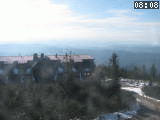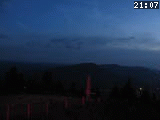Lysá hora 1323 m n. m. - královna Moravskoslezských Beskyd
Thursday 5. June 2025
History of the Village of Mankovice [ History ]

From history of the village Mankovice (since past up to these days)
Already in former times our village and its near surroundings were populated. It was confirmed in 1891 during construction of the route Suchdol - Budišov. At that time during shaft sinking in the places of today's stop there were recovered bronze subjects - fragments of various spirals, needles and pins. It did not concern burial-ground, but depot find, it means that these subjects were hidden purposely. According to judgment of experts the subjects date back to 5th century before Christ (to the beginning of so-called Hallstatt's period). One part is situated in the Earth museum in Opava.
Through Mankovice led also old business road. In former times the business roads were oriented themselves along river, in this case along the river Odra. Also the old business road - "Amber route" - leading from Danube to Baltic sea led in our region from Lipník, Drahotuše, Nydek, through Hynčice and Vražné over Odra and further in Mankovice in direction of "Samota" Suchdol, Životice and Butovice.
Whereas there exist no written documents about origin and foundation of most of towns and villages in our region, no such a document exists neither about Mankovice. Document of Knights of St. John of Jerusalem from 1188 in which some Stephanus de Mankowic performes as a witness during proceedings, can't be without any hazard and questions connected with the village Mankovice about which the historical sources keep silent during other 200 years. The first convincing written mention dates back to 1374 when Mankovice however did not still believe to Odry's demense. From indirect facts, especially from German settlement, than from elongated ground plan of the village we can come to a conclusion that it originated in the times of outer otherwise German colonization which happened in our region in the second half of the 13th and at the beginning of the 14th century. Therefore the origin and foundation of the village Mankovice can be put into the last decade of the 13th century, so in 1374, to which mention of its existence dates back, it already got over one century of development. It probably also existed settlement already one or two hundred years before and it was probably of Slavonic origin as well as in whole our region. Because it is written that until the 13th century it was valid a Slavonic right here. The settlers came under the condition that it will be set up and it will be let to them a German law that ensured them a greater freedom and privileges. They came from the region of today's Bavaria, according to the building of their habitations - closed to four sides and a yard inside. Also a frequent name Beier of German inhabitants can be derived from it.
The fact that Mankovice was during the 14th century part of Starý Jičín's demense of Kravaře is documented in the document from 1383. By this document Vok VI. of Kravaře sold to provost of Olomouc Vilém of Kortelangen for life revenues of the villages Jeseník, Mankovice and Horka, belonging to demense of Jičín. When after death of Jan of Kravaře his widow Anežka married in 1436 Jiří of Šternberk to whom belonged demense of Odry, Mankovice falled to demense of Odry, seem indefinitely.
In the late 1420's Odry region, and so also Mankovice, got into whirliging of fair events of Hussite revolution movement. In 1427 Hussite field troops captured even the town Odry. From fortress Odry they took expeditions into surroundings and also to Mankovice. They left Odry as late as 1434. The Ultraquist religion set in in our country which survived several centuries. Hussite power in Odry contributed however to considerable Czechisizing of so far predominantly German towns and villages. It was set up the Czech language as official language of documents and municipal books even in mainly German towns. To 1447 dates back also Czech name Mankovice that was held in official papers until 1634.
Round half of the 16th century even here was relatively soon enforced Lutheran reformation and already in 1553 there was in Odry's parish a Lutheral pastor Bonaventura. Lutherans overruled even Mankovice's parish at which already in 1483 the Lutheral pastor is mentioned. Number of Catholics was at that times small. As late as 1638 there was in Mankovice again the first Catholic priest.
During the Thirty Years' War, period of destroying, depredation and killing, the inhabitants of Mankovice were commited to great exam as well. Gangs of mercenaries killed and plundered. When the war was at the end, number of population was only one third, farm estates were waste, field rough and scrubby. There was a lack of tools, cattle, misery and hunger and unimaginable cultural failure. Still in 1654 four wolfs were shot during hunt. To this grew still other increasing of corvée duties and selfdom. The Silesian Wars scared the village as well. During Silesian War I. in 1742 happened at Mankovice's bridge a battle of emperor's army and Prussians who were put to flight here.
In 1781 an important event in the village happened. It was performed the first numbering of houses and in 1785 the first metering of the land. Still in 1770 the village had 76 houses, in 1795 already 95.
Local church "of the Visitation of the Virgin Mary" was built in 1795 in the course of one year. School teaching has existed in this place already since the time of reformation. In 1547 it was taught namely only religion, namely until 1635 only evangelic religion and from 1635 already Catholic religion. From 1774 according to regulation of empress Mary Teresa a school attendance was established for children from 6 to 12 year. In old ground book there is school mentioned in 1663 on the place where then in 1812 school building was built which was in 1875 extended of one storey. It is today's building of municipal office. As a school it served since 1974 when it was newly built. In the village there was also since 1926 Czech minority school and since 1926 also Czech kindergarten. At German village school the Czech language was taught since 1935 for two hours a week namely from the fourth year.
Mankovice has been already since 1920 supplied with electricity namely it delivered direct current of firm Till from the mill in Jeseník. Since 1935 already alternating current from Moravia-Silesian power stations. On 23rd July 1935 street lighting lighted for the first time.
In 1938 a firehouse was built.
On 10th October 1938 German army occupied according to Munich diktat Mankovice.
In 1945 May 5th and 6th it was fought of Mankovice.
In 1946 German population was transfered to Western Germany in several transports. New settlers came predominantly from Wallachia. In 1946 the village had more that 700 Czech inhabitants. They worked mostly like agriculturists and in local industry - at saw-mill with subsidiary production dating back to times before World War I.
In 1960's there was built behind the village under Pohořský hill Veterinary sanitary institution - Cardass disposal plant and selfservice at lower end.
In 1960 memorial of killed during World War I to memorial of liberation and to casualties of World War II was adapted.
In 1970 - 1979 a new school in the centre of the village, inn and cultural centre with movie hall, parking-site, municipal 6-housing unit and multi-purpose water reservoir were built. Cinema was in the village established in 1948 and then moved in 1974 to new movie hall.
During integration in 1980 - 1989 to the town Odry there was built in the village another new supermarket.
After re-liberation in 1990 up to these days a municipal water supply has been built and the village has been supplied with gas. An appearance of local cemetery was adapted and in 1997 a memorable place was established to former died German citizens and in 1998 the former German citizens living in Germany built here monument with names of the killed during World War I. and II.
Compiled according to groundworks by chronicler Anna Orlitová
Already in former times our village and its near surroundings were populated. It was confirmed in 1891 during construction of the route Suchdol - Budišov. At that time during shaft sinking in the places of today's stop there were recovered bronze subjects - fragments of various spirals, needles and pins. It did not concern burial-ground, but depot find, it means that these subjects were hidden purposely. According to judgment of experts the subjects date back to 5th century before Christ (to the beginning of so-called Hallstatt's period). One part is situated in the Earth museum in Opava.
Through Mankovice led also old business road. In former times the business roads were oriented themselves along river, in this case along the river Odra. Also the old business road - "Amber route" - leading from Danube to Baltic sea led in our region from Lipník, Drahotuše, Nydek, through Hynčice and Vražné over Odra and further in Mankovice in direction of "Samota" Suchdol, Životice and Butovice.
Whereas there exist no written documents about origin and foundation of most of towns and villages in our region, no such a document exists neither about Mankovice. Document of Knights of St. John of Jerusalem from 1188 in which some Stephanus de Mankowic performes as a witness during proceedings, can't be without any hazard and questions connected with the village Mankovice about which the historical sources keep silent during other 200 years. The first convincing written mention dates back to 1374 when Mankovice however did not still believe to Odry's demense. From indirect facts, especially from German settlement, than from elongated ground plan of the village we can come to a conclusion that it originated in the times of outer otherwise German colonization which happened in our region in the second half of the 13th and at the beginning of the 14th century. Therefore the origin and foundation of the village Mankovice can be put into the last decade of the 13th century, so in 1374, to which mention of its existence dates back, it already got over one century of development. It probably also existed settlement already one or two hundred years before and it was probably of Slavonic origin as well as in whole our region. Because it is written that until the 13th century it was valid a Slavonic right here. The settlers came under the condition that it will be set up and it will be let to them a German law that ensured them a greater freedom and privileges. They came from the region of today's Bavaria, according to the building of their habitations - closed to four sides and a yard inside. Also a frequent name Beier of German inhabitants can be derived from it.
The fact that Mankovice was during the 14th century part of Starý Jičín's demense of Kravaře is documented in the document from 1383. By this document Vok VI. of Kravaře sold to provost of Olomouc Vilém of Kortelangen for life revenues of the villages Jeseník, Mankovice and Horka, belonging to demense of Jičín. When after death of Jan of Kravaře his widow Anežka married in 1436 Jiří of Šternberk to whom belonged demense of Odry, Mankovice falled to demense of Odry, seem indefinitely.
In the late 1420's Odry region, and so also Mankovice, got into whirliging of fair events of Hussite revolution movement. In 1427 Hussite field troops captured even the town Odry. From fortress Odry they took expeditions into surroundings and also to Mankovice. They left Odry as late as 1434. The Ultraquist religion set in in our country which survived several centuries. Hussite power in Odry contributed however to considerable Czechisizing of so far predominantly German towns and villages. It was set up the Czech language as official language of documents and municipal books even in mainly German towns. To 1447 dates back also Czech name Mankovice that was held in official papers until 1634.
Round half of the 16th century even here was relatively soon enforced Lutheran reformation and already in 1553 there was in Odry's parish a Lutheral pastor Bonaventura. Lutherans overruled even Mankovice's parish at which already in 1483 the Lutheral pastor is mentioned. Number of Catholics was at that times small. As late as 1638 there was in Mankovice again the first Catholic priest.
During the Thirty Years' War, period of destroying, depredation and killing, the inhabitants of Mankovice were commited to great exam as well. Gangs of mercenaries killed and plundered. When the war was at the end, number of population was only one third, farm estates were waste, field rough and scrubby. There was a lack of tools, cattle, misery and hunger and unimaginable cultural failure. Still in 1654 four wolfs were shot during hunt. To this grew still other increasing of corvée duties and selfdom. The Silesian Wars scared the village as well. During Silesian War I. in 1742 happened at Mankovice's bridge a battle of emperor's army and Prussians who were put to flight here.
In 1781 an important event in the village happened. It was performed the first numbering of houses and in 1785 the first metering of the land. Still in 1770 the village had 76 houses, in 1795 already 95.
Local church "of the Visitation of the Virgin Mary" was built in 1795 in the course of one year. School teaching has existed in this place already since the time of reformation. In 1547 it was taught namely only religion, namely until 1635 only evangelic religion and from 1635 already Catholic religion. From 1774 according to regulation of empress Mary Teresa a school attendance was established for children from 6 to 12 year. In old ground book there is school mentioned in 1663 on the place where then in 1812 school building was built which was in 1875 extended of one storey. It is today's building of municipal office. As a school it served since 1974 when it was newly built. In the village there was also since 1926 Czech minority school and since 1926 also Czech kindergarten. At German village school the Czech language was taught since 1935 for two hours a week namely from the fourth year.
Mankovice has been already since 1920 supplied with electricity namely it delivered direct current of firm Till from the mill in Jeseník. Since 1935 already alternating current from Moravia-Silesian power stations. On 23rd July 1935 street lighting lighted for the first time.
In 1938 a firehouse was built.
On 10th October 1938 German army occupied according to Munich diktat Mankovice.
In 1945 May 5th and 6th it was fought of Mankovice.
In 1946 German population was transfered to Western Germany in several transports. New settlers came predominantly from Wallachia. In 1946 the village had more that 700 Czech inhabitants. They worked mostly like agriculturists and in local industry - at saw-mill with subsidiary production dating back to times before World War I.
In 1960's there was built behind the village under Pohořský hill Veterinary sanitary institution - Cardass disposal plant and selfservice at lower end.
In 1960 memorial of killed during World War I to memorial of liberation and to casualties of World War II was adapted.
In 1970 - 1979 a new school in the centre of the village, inn and cultural centre with movie hall, parking-site, municipal 6-housing unit and multi-purpose water reservoir were built. Cinema was in the village established in 1948 and then moved in 1974 to new movie hall.
During integration in 1980 - 1989 to the town Odry there was built in the village another new supermarket.
After re-liberation in 1990 up to these days a municipal water supply has been built and the village has been supplied with gas. An appearance of local cemetery was adapted and in 1997 a memorable place was established to former died German citizens and in 1998 the former German citizens living in Germany built here monument with names of the killed during World War I. and II.
Compiled according to groundworks by chronicler Anna Orlitová

LOCATION
- Village or Town/City: Mankovice
- District of Administration 2: Odry
- District of Administration 3: Odry
- Region NUTS 4: Okres Nový Jičín
- Region NUTS 3: Moravskoslezský kraj
- Region NUTS 2: Moravsko-Slezsko
- Tourist region: 40 Poodří
- Destination: Severní Morava a Slezsko
INFORMATION: http://www.mankovice.cz
Type: History
LAST MODIFY: Ivana Náplavová org. 56, 28.11.2003 v 10:26 hodin



